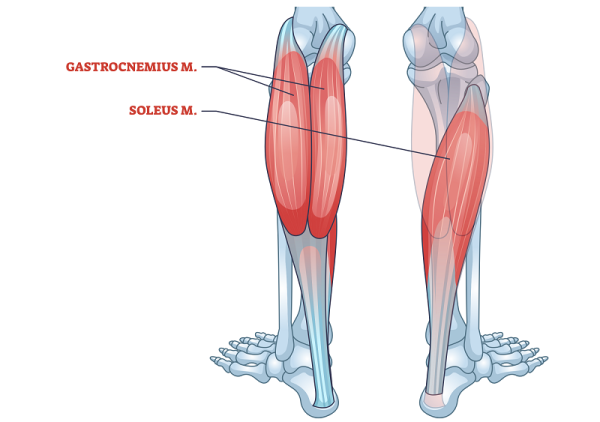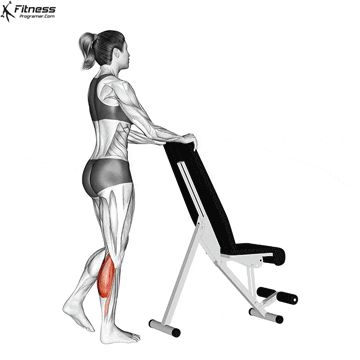Overview
The standing single leg calf raise is a unilateral calf-strengthening exercise that isolates one leg at a time to develop muscular balance, ankle control, and joint stability. It is one of the most accessible and effective movements for targeting both heads of the gastrocnemius and, to a lesser extent, the soleus, depending on knee position.
The non-working leg is typically bent and off the ground, while the working foot is elevated on a step or flat surface to allow a deep stretch at the bottom. By training one leg at a time, this exercise helps address imbalances, correct compensatory movement patterns, and reinforce joint resilience for both everyday movement and athletic performance.
How to Perform the Standing Single Leg Calf Raise
Setup: Stand near a bench, rack, or other support for balance. Place the ball of one foot on a raised surface (like a step or plate) with the heel hanging off.
Position the Non-Working Leg: Lift the opposite foot off the ground, bending the knee so it doesn’t assist.
Start in a Full Stretch: Allow your heel to drop below the step to feel a stretch in the calf of the working leg.
Lift Through the Forefoot: Press through the ball of the foot and raise your heel as high as possible in a controlled motion.
Pause and Contract: Squeeze the calf at the top for 1–2 seconds.
Lower Slowly: Let the heel return below the step in a slow, controlled descent to emphasize eccentric loading.
Repeat: Perform the desired number of reps, then switch sides.
Tips for Proper Form
Use a wall or rail lightly for balance, but avoid leaning forward or to the side.
Focus on full range of motion—don’t cut short the stretch or the peak contraction.
Keep hips level and square to avoid compensating with the pelvis.
Control the descent—eccentric loading is key for tendon health and muscle development.
Engage the toes actively, especially the big toe, to ensure proper push-off.
Common Mistakes to Avoid
Bouncing at the bottom, which reduces muscle tension and stresses the Achilles.
Using momentum or swinging the body, which shifts focus away from the calf.
Favoring one side or twisting the torso to compensate for balance loss.
Allowing the heel to drop too far aggressively, risking overextension of the Achilles tendon.
Neglecting balance control, which turns the movement into more of a challenge to coordination than strength.
Benefits of the Standing Single Leg Calf Raise
Builds balanced calf strength and size, addressing left-right asymmetries.
Improves ankle stability, crucial for runners, field athletes, and older adults.
Enhances proprioception and balance, benefiting injury prevention and coordination.
Provides full range loading, strengthening the calf through both stretch and contraction.
Can be performed anywhere, making it ideal for home, travel, or minimalist routines.
Strengthens connective tissue, especially the Achilles tendon.
Scales easily with tempo, load, volume, or instability for progressive adaptation.
How to Incorporate Into Your Routine
For Beginners: Start with bodyweight only, performing 2–3 sets of 10–12 reps per side with full control.
For Hypertrophy: Add a dumbbell in the working-side hand and perform 3–5 sets of 12–15 reps, focusing on controlled eccentrics and full peak contraction.
For Strength: Hold a heavier dumbbell or kettlebell and perform 4 sets of 6–10 reps per leg, pausing at the top.
For Functional Training: Combine with balance drills or ankle stability exercises in a lower-limb circuit.
For General Fitness: Add this as a weekly accessory to address muscle imbalances and promote gait efficiency.
For Runners and Athletes: Perform 2–4 times per week to improve unilateral lower-leg drive, reduce injury risk, and enhance push-off mechanics.
Standing Single Leg Calf Raise: Muscles Worked

Frequently Asked Questions
Is the single leg calf raise better than the double leg version?
Both have value. The single leg variation provides better unilateral loading and balance development, while the double leg version allows for heavier loads and volume.
What surface should I use for this exercise?
Use a sturdy step, bumper plate, or calf raise block that allows the heel to dip below parallel for a full stretch.
How can I make it harder without gym equipment?
Try slowing down the tempo, pausing at the top and bottom, or wearing a weighted vest or backpack.
Should I do this barefoot or in shoes?
Barefoot training can enhance foot stability and intrinsic muscle activation but may be too advanced for some. Start with minimalist footwear and progress cautiously.
Why do my calves cramp during this exercise?
Calf cramps often occur from fatigue, dehydration, or poor motor control. Reduce intensity, increase hydration, and build volume gradually.

